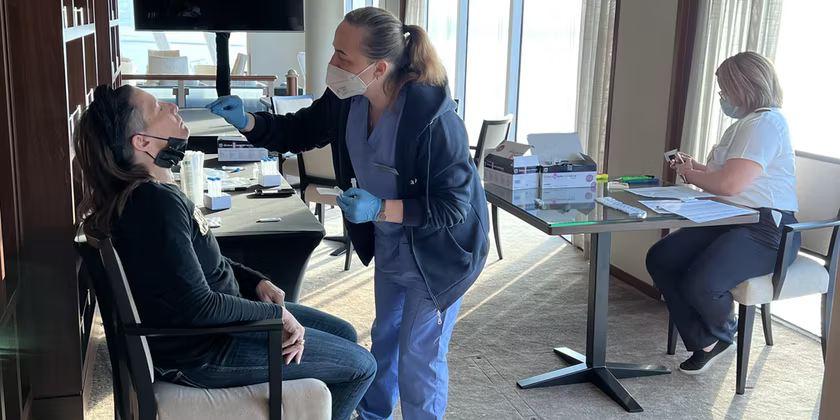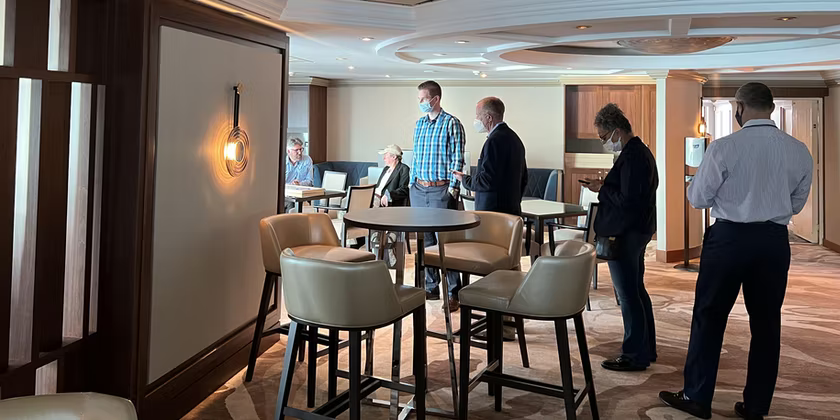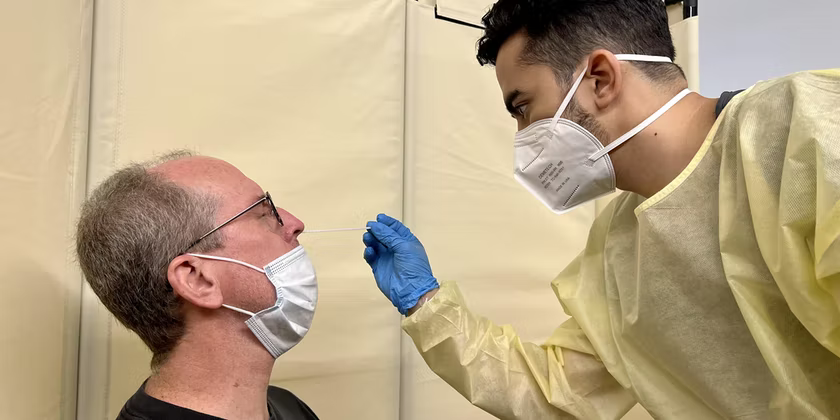The longest 15 minutes in cruising right now is the time you sit, waiting for the results of your COVID-19 test to come back.
Maybe you’re in your house or hotel room, hitting the refresh button on your email so you can get a negative result at least 48 hours before your cruise. Maybe you’ve already traveled to the terminal, and you’re sitting there nervously before you’re given the green light to board. Maybe — and this is by far the worst one — you’ve finished your European ocean or river cruise and that negative result means you’re either going home or heading into an unappealing hotel quarantine.
COVID test anxiety is real. It doesn’t matter where you are in the process. Requiring a test to travel is nerve-wracking and unpredictable. Testing positive can ruin your vacation and other future plans in an instant. And cruise line presidents are increasingly saying it’s hurting the industry.
Anxiety About COVID Test: U.S. Stands Alone in Requirement for Entry
The U.S. government still requires all people over 2 years old flying into the country, including those who are vaccinated and boosted, to produce proof of a negative COVID-19 test taken 24 hours before you enter.
The U.S. stands nearly alone with such a policy. The U.K., Canada and most European Union countries have dropped their requirements, making it easier for them to attract tourists. Even most Caribbean countries that were cautious at the height of the pandemic allow vaccinated passengers to come in without a test.
The mandate shows no signs of going away, despite lobbying from the U.S. Travel Association, International Air Transport Association, ASTA, Cruise Lines International Association and other travel entities. International businesses and the U.S. Chamber of Commerce have also come out against the testing requirement, as it stifles corporate travel and meetings.
“The U.S. is woefully behind,” Celebrity Cruises President and CEO Lisa Lutoff-Perlo told Cruise Critic in an interview on her line’s newest ship, Celebrity Beyond. “We keep hearing they’re going to change it. They are going to change it, but they need to hurry up.”
Dropping the mandate would be a boon for the European summer cruise season, which is just starting to pick up. Many cruise lines, including Celebrity, Norwegian Cruise Lines and Royal Caribbean, have some of their newest and biggest ships deployed to the Mediterranean for what is normally a booming season.
While Caribbean cruise ships are returning to full capacity, those European ships could continue to feel empty if Americans stay away. Cruising has fans worldwide, and cruise lines court those international passengers. But it’s hard to fill a ship the size of Wonder of the Seas — the biggest ship in the world at 5,734 passengers — without a healthy proportion of Americans.
“The U.S. government has to catch up, and that’s the thing for Americans,” Lutoff-Perlo said. “They are really sick of staying home, and they don’t want to get tested to come.”
Small and Luxury Ships Hurt, Too
 International itineraries to unique ports are the calling card of small and luxury cruise lines, which often don’t have ships in Alaska and the Caribbean to fall back on.
International itineraries to unique ports are the calling card of small and luxury cruise lines, which often don’t have ships in Alaska and the Caribbean to fall back on.
Azamara, for example, has all four of its ships outside the U.S. this summer. While customers from other countries have been booking at rates that approach pre-pandemic levels, “North America has been a bit of fits and starts,” Azamara President Carol Cabezas told us from aboard her new ship, Azamara Onward.
“The testing is a big part of it,” she said. “It gives them (passengers) a bit of a pause.”
Echoed Windstar President Chris Prelog, speaking exclusively to Cruise Critic from the cruise industry’s 2022 Seatrade Global trade event: “The biggest issue is the test coming back to the United States. It’s still the biggest hurdle.”
One trend small ship and luxury lines have seen is passengers trying to minimize the testing issues by going abroad for longer periods and booking back-to-back cruises, Cabezas said.
Azamara has also tried to keep COVID-19 discrepancies between different destinations to a minimum, by leaning into their country-intensive itineraries. “It was a bit of a challenge to visit multiple countries,” Cabezas said of cruising’s restart in 2021, when different countries had different rules on masks, testing and excursions. “Going in that direction was helpful.”
COVID Test Anxiety and Fear of Getting Stuck Overseas Remains

Still, no matter how long you stay away from the U.S., eventually you have to get home. And that’s where anxiety over your COVID-19 re-entry test really kicks in.
I cruised in Europe twice in 2021 and twice this year, as well as once in South America. Like many of our readers, I’m more concerned about catching COVID-19 overseas and having a hotel quarantined inflicted on me now than I was last year.
For one, the current variants are sneaky; many vaccinated and boosted people present without symptoms. That means you really won’t know if you’re positive until right before you need to fly, potentially jeopardizing work and events back home.
Second, other COVID-19 prevention methods have gone away, making it more likely that the virus could spread. Masks are no longer required on international flights, for example, or onboard ships as they were in 2021. While dropping masks mandates makes cruising a far more pleasant experience — bookings surged after the mask requirements were dropped, cruise line presidents say — it does mean your risk levels go up.
Finally, re-entry tests add more costs and hassle to your trip. While some cruise lines, such as Silversea and Viking, include the cost of a re-entry COVID-19 test in your fare, others, such as Azamara and many river cruise lines, charge a fee. If you add a day or two to your trip, you often have to scramble to find a test provider, either at the airport or off site; in Ecuador, I had to run to an ATM to get foreign currency to pay for my test.
With Vaccines and Boosters Required, Why Need Tests?

All cruise lines require vaccines, and many European itineraries require you to have a booster to comply with country regulations. That offers a level of assurance onboard that you don’t always get on land; testing to get back into the U.S. on top of it seems like overkill.
“For Americans, if I’ve vaccinated to protect myself, I’m not even afraid of getting sick. I’m afraid I can’t come home,” Lutoff-Perlo said. “You have to worry about it. Even if you’re retired, do you really want to extend your stay by however many days?”
Testing to get on cruise ships will probably stick around for a while, as the process is required in the current cruise guidelines set out by the CDC. Only UnCruise, an expedition line with ships carrying fewer than 200 passengers, has gotten rid of a pre-cruise testing requirement.
While finding tests before you cruise can be also be an expense and a hassle, most cruisers are OK with the process. In Cruise Critic’s sentiment survey in mid-April, 45 percent of cruisers said they felt most comfortable booking a cruise with a testing requirement.
Although no one knows when the government will drop the re-entry test requirement, one thing is certain: When it goes away, cruise business will boom, cruise line presidents say.
“When that judge ruled that the mask mandate was eliminated, bookings surged,” Lutoff-Perlo said. “Imagine when the testing requirement goes away?”
Added Michelle Lardizabal, chief sales officer North America for Azamara: “I’m looking forward to the (booking) spike when that is lifted.”
Click here to read the full article:


Recent Comments